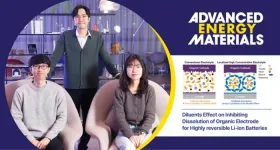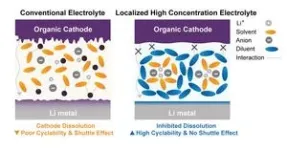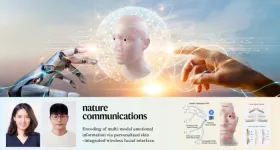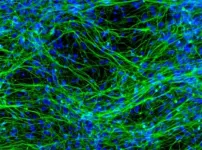(Press-News.org) In a groundbreaking study, Professor Won-Jin Kwak in the School of Energy and Chemical Engineering at UNIST, in collaboration with researchers from Hanyang University, have pioneered a method to significantly enhance the performance and lifespan of organic electrode-based batteries. The findings promise to accelerate the commercialization of eco-friendly batteries and pave the way for further advancements in the field.
Organic electrodes have long been recognized for their cost-effectiveness and natural abundance, making them a promising alternative to traditional lithium-ion battery materials. However, the dissolution of these active materials in the electrolyte has posed a significant challenge, limiting their practical application in batteries. To address this issue, the research team introduced diluted electrolytes as non-solvating electrolytes, effectively mitigating the physical limitations of high-concentration electrolytes (HCEs) and suppressing the dissolution of organic electrodes.
The study focused on perylene-3,4,9,10-tetracarboxylic dianhydride (PTCDA), a prominent organic electrode material, and demonstrated remarkable improvements in capacity retention and rate performance when using diluted electrolytes. Over 1000 cycles, the PTCDA-based battery achieved an impressive 91% capacity retention at 1000 mA g−1. Through a combination of electrochemical and spectroscopic measurements, as well as molecular dynamics simulations, the team successfully inhibited the dissolution of the active material and mitigated the detrimental shuttle effect, thereby preventing capacity loss.
This research presents a promising strategy for achieving highly reversible organic electrode-based lithium-ion batteries, opening up new possibilities for the development of more efficient and sustainable energy storage solutions. By utilizing non-solvating electrolytes, the team has overcome the limitations associated with organic electrode materials and demonstrated a path towards extending the lifespan of these eco-friendly batteries.
Professor Kwak emphasized the significance of this breakthrough by saying “The development of non-solvating electrolytes provides an effective approach to suppress the elution of organic electrode materials, without compromising capacity or output. This study represents a major step towards practical applications of organic electrode-based batteries.”
The research team further validated their findings through computational methods and experimental verification, confirming that the use of the developed electrolyte led to the effective suppression of elution. In more than 1,000 charge/discharge experiments, over 80% of the battery capacity was retained, in sharp contrast to conventional electrolytes, which exhibited less than 50% capacity after just 20 charge/discharge cycles.
The potential of organic electrode-based secondary batteries using non-solvating electrolytes holds great promise in overcoming resource depletion and rising material prices. As researchers continue to tackle the challenges associated with these batteries, this study sets the stage for future breakthroughs and advancements in the field.
The findings of this research have been published in the Advanced Energy Materials on January 19, 2024. The research was supported by the National Research Foundation of Korea (NRF) and the Ministry of Science and ICT (MSIT).
Journal Reference
Hyun-Wook Lee, Youngoh Kim, Joo-Eun Kim, et al., “Diluents Effect on Inhibiting Dissolution of Organic Electrode for Highly Reversible Li-Ion Batteries,” Adv. Ener. Mater., (2024).
END
Non-solvating electrolytes enhance performance of organic electrode-based batteries
2024-02-22
ELSE PRESS RELEASES FROM THIS DATE:
NIFTY® DNBSEQ-G99 platform receives CE-IVDD certification and advances prenatal care standards
2024-02-22
BGI Europe A/S, a wholly owned subsidiary of BGI Genomics, announced its NIFTY® non-invasive prenatal testing kit and software (CE-IVDD List B) were granted an extension under its existing CE-IVDD certification to include the DNBSEQ-G99 model to meet the European Union regulations for medical devices.
In January 2024, BGI Genomics unveiled the NIFTY® ultra-fast non-invasive prenatal genetic testing product, utilizing the innovative DNBSEQ-G99 platform. Designed for both small and medium throughput, this platform ensures top-notch testing ...
Living in violent neighborhoods affects children's brain development
2024-02-22
Living in neighborhoods with high levels of violence can affect children’s development by changing the way that a part of the brain detects and responds to potential threats, potentially leading to poorer mental health and other negative outcomes, according to research published by the American Psychological Association.
However, nurturing parents can help protect kids against these detrimental effects, according to the study, published in the journal Developmental Psychology.
“Decades of research ...
World’s first real-time wearable human emotion recognition technology developed!
2024-02-22
A groundbreaking technology that can recognize human emotions in real time has been developed by Professor Jiyun Kim and his research team in the Department of Material Science and Engineering at UNIST. This innovative technology is poised to revolutionize various industries, including next-generation wearable systems that provide services based on emotions.
Understanding and accurately extracting emotional information has long been a challenge due to the abstract and ambiguous nature of human affects such as emotions, ...
MD Anderson acquires inducible switch technologies for cell therapy
2024-02-22
HOUSTON ― The University of Texas MD Anderson Cancer Center today announced it has acquired certain assets from Bellicum Pharmaceuticals, Inc. related to the CaspaCIDe® switch platform and the GoCAR® platform. The transaction also includes clinical-grade stocks of rimiducid, an agent used to trigger the switches.
As a result of this acquisition, MD Anderson may incorporate these platforms into its own cell therapy programs. The institution also intends to make the technology ...
UTSA doctoral student studies solutions to prevent contaminated water sources
2024-02-22
From Bangladesh to India to Texas, Tom Varner is leveraging his research to improve sources for drinking water around the world.
Varner, a UTSA doctoral student in environmental science and engineering, explored the mobility of arsenic from the sediments surrounding the Meghna River in Bangladesh as part of a National Science Foundation-funded project.
The river flows through central Bangladesh, where elevated concentrations of arsenic in the groundwater threaten the welfare of millions of people. Long-term exposure to arsenic, which is toxic when ingested, can lead ...
Treating newly-diagnosed Crohn’s patients with advanced therapy leads to dramatic improvements in outcomes
2024-02-22
A large-scale clinical trial of treatment strategies for Crohn’s disease has shown that offering early advanced therapy to all patients straight after diagnosis can drastically improve outcomes, including by reducing the number of people requiring urgent abdominal surgery for treatment of their disease by ten-fold.
The PROFILE trial, led by researchers at the University of Cambridge, involved 386 patients with newly-diagnosed active Crohn’s disease. Recruiting from 40 hospitals across the UK, and supported by the National Institute for Health and Care Research (NIHR) Clinical Research Network, it sought to test whether a biomarker – a genetic signature ...
Uncovering anxiety: Scientists identify causative pathway and potential cures
2024-02-22
Anxiety-related disorders can have a profound impact on the mental health and quality of life of affected individuals. Understanding the neural circuits and molecular mechanisms that trigger anxiety can aid in the development of effective targeted pharmacological treatments. Delta opioid receptors (DOP), which localize in the regions of the brain associated with emotional regulation, play a key role in the development of anxiety. Several studies have demonstrated the therapeutic effects of DOP agonists (synthetic compounds which selectively bind to DOPs and mimic the effect of ...
Stronger storms free more nutrients from mud flats
2024-02-22
If storms become stronger in the future due to climate change, more nitrogen may be released from the bottom of coastal seas. This is shown by research of marine biogeochemist Dunia Rios-Yunes at NIOZ in Yerseke. Rios-Yunes will defend her PhD-thesis today at the University of Utrecht. “The dynamics of nutrients in deltas and estuaries have been a bit of a blind spot for marine science, so far”, she says.
Inflatable couch
For her experiments, Rios-Yunes spent many hours on an inflatable couch on ...
New study is first step in predicting carbon emissions in agriculture
2024-02-22
MINNEAPOLIS / ST. PAUL (02/19/2024)—For the first time, researchers at the University of Minnesota Twin Cities (UMN) and the University of Illinois Urbana-Champaign (UIUC) have demonstrated that it is possible to provide accurate, high-resolution predictions of carbon cycles in agroecosystems, which could help mitigate the impacts of climate change.
The study by scholars from the UMN-led National Artificial Intelligence Institute for Climate-Land Interactions, Mitigation, Adaptation, Tradeoffs and Economy (AI-CLIMATE) and UIUC-led Agroecosystem Sustainability ...
Air pollution hides increases in rainfall
2024-02-22
We know that greenhouse gas emissions like carbon dioxide should increase rainfall. The emissions heat the atmosphere, causing a one-two punch: warmer oceans make it easier for water to evaporate, and warmer air can hold more water vapor, meaning more moisture is available to fall as rain. But for much of the 20th century, that increase in precipitation didn’t clearly show up in the data.
A new study led by researchers at the Department of Energy’s Lawrence Berkeley National Laboratory (Berkeley ...







